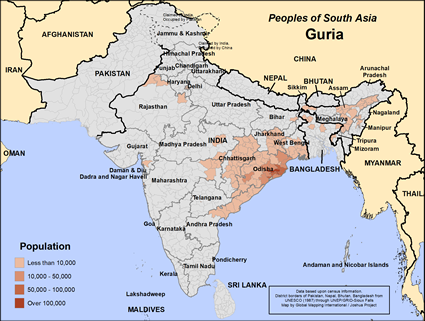Guria in India

Photo Source:
Copyrighted © 2026
Henk Sebregts All rights reserved. Used with permission |

Map Source:
People Group Location: Omid. Other geography / data: GMI. Map Design: Joshua Project
|
| People Name: | Guria |
| Country: | India |
| 10/40 Window: | Yes |
| Population: | 744,000 |
| World Population: | 744,000 |
| Primary Language: | Odia |
| Primary Religion: | Hinduism |
| Christian Adherents: | 0.07 % |
| Evangelicals: | 0.00 % |
| Scripture: | Complete Bible |
| Ministry Resources: | Yes |
| Jesus Film: | Yes |
| Audio Recordings: | Yes |
| People Cluster: | South Asia Hindu - other |
| Affinity Bloc: | South Asian Peoples |
| Progress Level: |
|
Introduction / History
The Guria are a subset of the larger Halwai Indian caste. The Guria live in east central India and specialize in making candy and sweets. "Gur" means unrefined sugar. Most Guria make confections and sell the sweets in shops they own. They would fit into the Indian middle class. Some Guria produce candy in factories and would be thought of as wealthy. Candies and sweets play a big part in Hindu births, weddings and holidays. All Hindus will purchase and eat candy made by the Guria, even the Brahmin highest caste.
The Guria encourage higher education in both their sons and daughters. Some Guria have left their traditional occupation of making candy and work in public service jobs, as merchants and in agriculture. University graduates work in professions like medicine, law, in engineering and in computer science.
The primary language of the Guria is Odia. They also speak Hindi and other regional languages. College educated Guria speak English.
Where Are they Located?
The vast majority of the Guria live in the east Indian state of Odisha. Smaller groups of Guria live throughout the nation of India.
What Are Their Lives Like?
The Guria are proud of their Hindu heritage and their profession of making candy and sweets. They are endogamous, that is, they marry within their caste. Parents arrange marriages with the consent of the young people. The newly married couple lives with or near the groom's family. This practice is changing as young people often move to urban areas to start their own businesses.
The Guria pay Brahmin priests to officiate at their important life ceremonies. Sons inherit property when the father dies. The eldest son takes the family home and becomes responsible for his mother and younger siblings. Their dead are cremated and the ashes scattered in a holy river.
The Guria are not vegetarians. As Hindus, they will not eat beef. Their main foods are rice, wheat, lentils, dairy products and seasonal vegetables and fruit. The use of alcohol is frowned upon.
What Are Their Beliefs?
Almost all Guria practice Hinduism, the ancient religion of India. They worship and serve the gods of the Hindu pantheon including Shiva, the destroyer god and his wife Durga, the mother-warrior goddess. The Guria also worship the god of good fortune and wisdom, Ganesha. The Guria visit Hindu temples to offer prayers, incense, flowers and foods to their gods. The Guria perform rituals and good works in an attempt to break from the endless cycle of birth, death and rebirth.
The Guria participate in the yearly Hindu holidays like Holi, the spring festival of colors, Diwali, the festival of lights, Ramnavmi, Rama's birthday and Janamashtami, Krishna's birthday.
What Are Their Needs?
The Guria need to hear the life-changing message of Jesus Christ in a way they can understand. They need to see the love of Christ practiced by his followers. The Guria need to see that true wealth is found only in Jesus Christ not in their financial assets.
Prayer Points
Pray for Guria families to be drawn to Jesus and to the Bible to find out more about this man, Jesus.
Pray the Lord will open the hearts of the Guria people to desire God's blessings through a movement of family-based discovery Bible studies.
Pray that many of the Guria people will come to love God with their whole being and will walk in His ways.